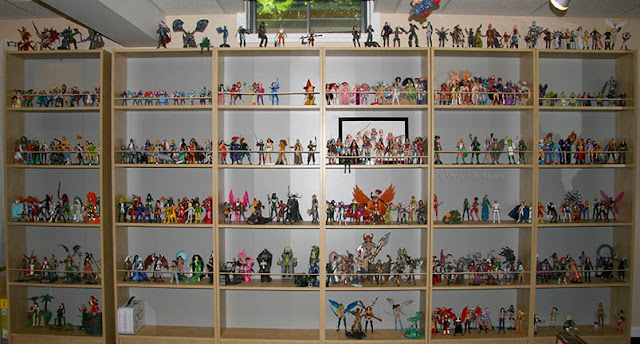Maybe you're new to collecting, maybe you're a collector who's never really thought about your collection in terms of "inventory" or "asset" – here's some things to consider, not just for the sake of avoiding the annoyance of duplicate purchases.
Before I go any further: nothing in this post is intended as legal advice. I am not an attorney. If you have questions about insurance, an insurance claim, or legal issues about an insurance claim, you should speak to a qualified attorney in your state.
Insurance
If you have renter's or homeowner's insurance and something catastrophic happens where you need to make a claim, how will you know what to claim or how to prove it without documentation. Maintaining a good, current database of your collection is vital for this. Photograph everything, keep a list of what you have, and if you have really valuable collectibles, keep detailed purchase records. An insurance adjuster won't just pay a claim out on your say-so. Note: read your policy closely to see if it even covers your collectibles; it may not.
No More Duplicate Buying
This alone will save you hundreds, but it only works if you maintain a current up-to-date database. (It also helps avoid having to return gifts that might be duplicates.)
Track Missing Pieces
If your collection is missing a piece, and the collection is large, sometimes it can be hard to recall which piece(s) might be missing just by looking at a display. With a database tailored to your needs, you can flag those missing items. Just remember that when you acquire something that you adjust the data accordingly.
Track Spending
Maybe you don't know how much you spend on your hobby, and you want to. Maintaining a database will help you do that. (You might not thank me for that suggestion...)Gift Suggestions
"What do you want for your birthday?" (sigh) Look, I know it, you know it: Amazon wish lists are a thing. Unfortunately, not everyone is able or willing to use that to our advantage. By using the suggestion above, you can also give ideas to people who aren't willing to hit Amazon up to shop. (If they don't do ebay, either, and all your ideas are deep dives, you'll have to get creative.)
Bragging Rights
I'm not gonna lie: When my collection tipped over eight hundred figures, it was a little thrilling. But it's hard to be thrilled about or proud of what you're unaware of. Geeks are cool now, right? So let your geek flag fly, my friend, and be proud of that collection you've amassed. Share it with the world, and if your friends give you s#!t about it... well, maybe you need better friends. (Seriously.)So how does it work?
I maintain my inventory using a free open source database software, called Open Office from Apache. (Download it here.) Maybe you already have the Microsoft suite that includes Excel and love it (I loathe it), either will do what you need with some tinkering. Here's a screenshot of how my customized spreadsheet looks:
 |
| OpenOffice spreadsheet |
I cannot recommend OpenOffice highly enough, honestly. It's a free application, no one's paying me to say that, I'm not one of the devs, I don't know any of the devs – it's just good, simple, easy-to-use and will export the whole database as a PDF so I can read it on my phone or send it to someone else.
Column J, not visible in the above image, is "purchased from/price." I only recently started tracking that information, so it's mostly empty. You can include as much or as little info as you want. I included assortment and stock numbers for many, but not UPC, because I don't want to type all those numbers. The two lines in blue text are Wonder Woman figures, the only character I currently track in a separate color, and the only character I maintain a significant collection of variants in. (Using a different color just makes it faster to see at a glance while scrolling.)
My database is strictly alphabetical by name, regardless of series. But that's my database, and what works for me. However you need to keep track of your figures to make it easy for you to maintain an accurate inventory is the way you should do it.
Documentation
If you're going to keep your receipts, be sure to label them clearly. If you go to Target and buy action figures, it's not clear what you bought, typically. Since the paper is sensitive to heat and grease, be sure to keep them someplace cool and dry, or better still: scan the receipt and keep that with the photographs you take of the item.
Take pictures of the front and back of the figure in the package, even if you plan to take it out (as I do). Sometimes those packages have information about the wave or series that might be useful about other items that are coming out later or out now that you might want to pick up. The photograph also helps provide documentation of the thing in your possession if you have to make an insurance claim. (Again, read your insurance claim closely to see if your collectibles are covered under your policy. If your collection is valuable and your homeowner's insurance is not great, there are insurance policies available just for collectibles.)
 | ||
| Inventory photos, front and back (one combined image); this image also shows the price tag on the piece. |













































